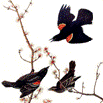Center, Internet, Wildlife Damage Management

Bird Control Seminars Proceedings
Document Type
Article
Date of this Version
November 1979
Abstract
Birds are not normally attracted to waste ponds as a food source but, rather, as a place to loaf or rest. This is why sound patterns designed to affect bird behavior act as an effective deterrent to birds in these less attractive sites. The number and species of local or resident birds that frequent the site depend upon the degree of suitability found during their first visit. They can often be discouraged from using a waste pond by eliminating or reducing nearby roosting, loafing, nesting sites, and preferred food sources. Migratory birds present a different problem in that as they move into or fly over an area, on a seasonal basis, large flocks often will visit a waste pond. They are not in- terested in roosting or nesting, just resting and dabbling for food items. By the time they discover that there is no food in the pond, many of them have either absorbed or in- gested a lethal quantity of waste materials. In waste pond situations an integrated management program incorporating sound and visual devices has been effective in repelling the birds before they land. Generally speaking, each bird species responds differently to a given sound pattern. Sound patterns elicit an aversion response that can be rated simply as poor, fair, good, and excellent. There are three principal sound types to work with which can be easily understood with a few basic definitions.

